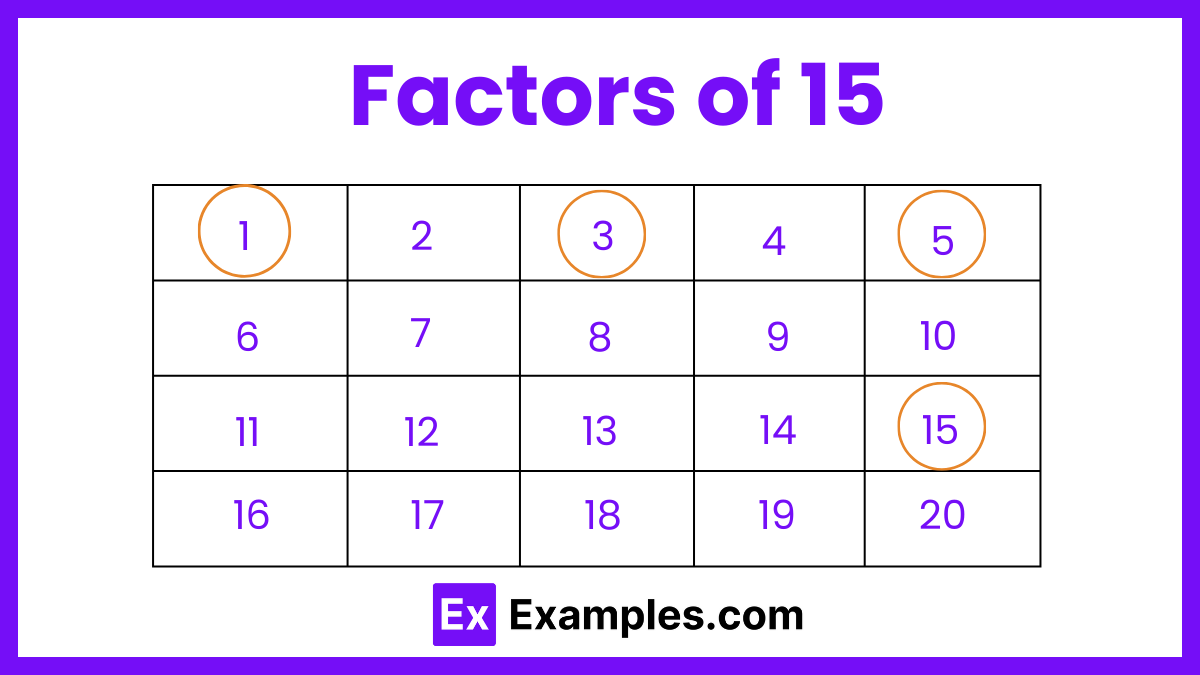What are the factors of 15?
1, 3, 5, 15
1, 2, 4, 8
2, 3, 6, 12
1, 2, 5, 10

The factors of 15 is essential for various mathematical applications and problem-solving techniques. Factors are numbers that divide a given number without leaving a remainder. For 15, the factors are 1, 3, 5, and 15. Recognizing these factors helps in simplifying fractions, finding common denominators, and solving algebraic equations. Moreover, knowing the factors of a number like 15 can aid in real-life scenarios such as grouping items and distributing resources evenly. This introduction will guide you through identifying the factors of 15, their significance in mathematics, and practical applications in everyday life.

The factors of 15 are the numbers that can be multiplied together to produce 15, as well as those that can divide 15 without leaving a remainder. These factors are 1, 3, 5, and 15. Understanding these factors is fundamental in mathematics, as they are used in simplifying fractions, finding common denominators, and solving various algebraic problems. For instance, 3 and 5 are prime factors of 15, meaning they are prime numbers that, when multiplied, result in 15.
Here are the factor pairs of the number 15:
These are the only factor pairs of 15, as no other integers multiply together to reach this product.
Start with the smallest prime number, which is 2. Determine if 15 can be divided evenly by 2. Since 15 is an odd number, it cannot be divided by 2.
Move to the next smallest prime number, which is 3. Check if 15 can be divided evenly by 3. Since 15 divided by 3 equals 5, 3 is a prime factor of 15.
The result from the previous division is 5. Since 5 is a prime number itself and only divisible by 1 and 5, it is also a prime factor of 15.
At this point, you have determined that the prime factors of 15 are 3 and 5, as multiplying them gives the original number (3 × 5 = 15).
Identifying the factors of a number like 15 is a fundamental math skill. Here are some practical tips to make this process as efficient as possible
The prime factors of 15 are the prime numbers that multiply together to equal 15. The prime factors of 15 are 3 and 5.
The greatest common factor (GCF) of 15 and another number is the largest number that divides both 15 and the other number exactly. For example, the GCF of 15 and 20 is 5.
Yes, the factors of 15 are always whole numbers because they are the numbers that divide 15 exactly without leaving a remainder.
The sum of the factors of 15 (1, 3, 5, and 15) is calculated by adding them together: 1 + 3 + 5 + 15 = 24.
The common factors of 15 and 30 are the numbers that divide both 15 and 30 exactly. These common factors are 1, 3, 5, and 15.
The multiples of 15 are the numbers you get by multiplying 15 by integers. The first few multiples of 15 are 15, 30, 45, 60, 75, 90, 105, 120, 135, and 150.
Text prompt
Add Tone
10 Examples of Public speaking
20 Examples of Gas lighting
What are the factors of 15?
1, 3, 5, 15
1, 2, 4, 8
2, 3, 6, 12
1, 2, 5, 10
Which of the following is not a factor of 15?
5
6
8
11
If you multiply all factors of 15, what is the product?
225
30
120
45
Which pair of numbers are both factors of 15?
2 and 7
3 and 5
1 and 6
4 and 10
What is the greatest common factor of 15 and 45?
5
10
15
30
Which of these numbers is a factor of 15?
6
8
9
15
Which of the following is not a factor of 15?
1
3
4
5
How many factors does 15 have?
2
3
4
5
What is the sum of all factors of 15?
18
20
24
26
Which number is a factor of 15 that is less than 10?
5
9
8
12
Before you leave, take our quick quiz to enhance your learning!

